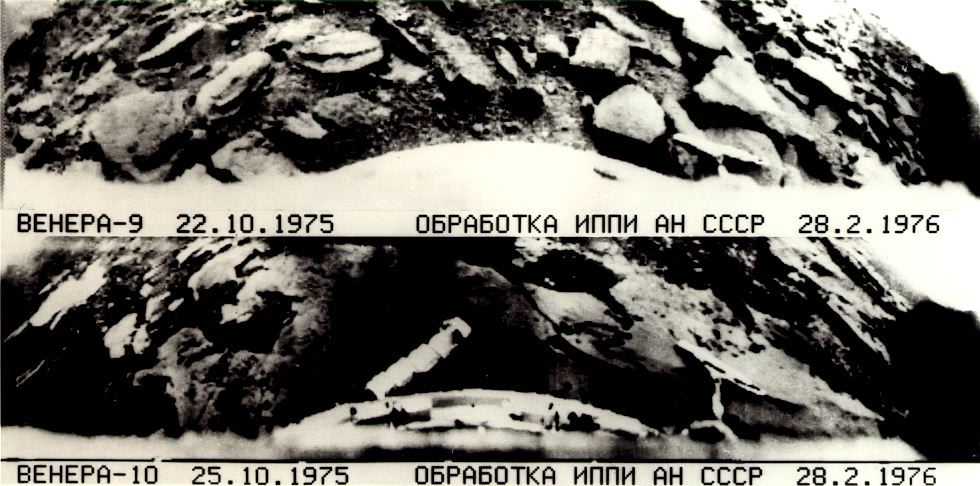|
|
|
#1 |
|
Avalon Senior Member
Join Date: Sep 2008
Location: So. Cal. U.S.
Posts: 4,205
|
Missions to Venus
Mission Country Launch Date Arrival Date Type Encounter Characteristics Venera 1 USSR February 12, 1961 ---- Flyby Now in solar orbit Mariner 2 USA August 27, 1962 December 14, 1962 Flyby Closest approach: 34,833 km Zond 1 USSR April 2, 1964 ---- Probe Now in solar orbit Venera 2 USSR November 12, 1965 ---- Flyby Communications failed just before arrival. Now in solar orbit. Venera 3 USSR November 16, 1965 ---- Atmospheric Probe Communications failed just before atmosphere entry. Crashed on Venus Venera 4 USSR June 12, 1967 October 18, 1967 Atmospheric Probe First probe to be placed directly in the atmosphere and to return atmospheric data. It was crushed by the pressure on Venus before it reached the surface. Mariner 5 USA June 14, 1967 October 19, 1967 Flyby Closest approach: 3900 km Venera 5 USSR January 5, 1969 May 16, 1969 Atmospheric Probe Burn-up Venera 6 USSR January 10, 1969 May 17, 1969 Atmospheric Probe Returned data down to within 11 km of the surface before being crushed by the pressure. Venera 7 USSR August 17, 1970 December 15, 1970 Lander First successful landing of a spacecraft on another planet. Returned 23 minutes of data. Venera 8 USSR March 27, 1972 July 22, 1972 Lander Returned data for 50 minutes Mariner 10 USA November 3, 1973 February 5, 1974 Flyby Dual planet mission to Venus and Mercury. Closest approach: 5700 km Images of cloud top Venera 9 USSR June 8, 1975 October 22, 1975 Orbiter Periapsis: 1560 km Apoapsis: 112,200 km Period: 48 hours, 18 min Inclination: 34* 10' Photographed clouds and looked at the upper atmosphere. Lander Transmitted first black and white pictures of the planet's surface Venera 10 USSR June 14, 1975 October 25, 1975 Orbiter Periapsis: 1620 km Apoapsis: 113,900 km Period: 49 hours, 23 min Inclination: 29* 30' Photographed clouds and looked at the upper atmosphere Lander Transmitted black and white photographs of the terrain. Pioneer Venus 1 (Pioneer 12) USA May 20, 1978 December 4, 1978 Orbiter Periapsis: 200 km Apoapsis: 66,000 km Period: 24 hours Inclination: 29* 30' Operated until 1992 when contact was lost. First spacecraft to use radar in mapping the planet's surface. Pioneer Venus 2 (Pioneer 13) USA August 8, 1978 December 9, 1978 Atmospheric Probe 4 probes parachuted through the atmosphere. Venera 11 USSR September 9, 1978 December 25, 1978 Flyby Closest approach: 25,000 km Lander Returned data for 95 minutes. Imaging systems failed. Venera 12 USSR September 14, 1978 December 21, 1978 Flyby Closest approach: 25,000 km Lander Returned data for 110 minutes. Electrical discharges were recorded. Venera 13 USSR October 30, 1981 March 1, 1982 Flyby Lander First color panoramic views of the planet's surface. Conducted soil analysis. Venera 14 USSR November 4, 1981 March 5, 1982 Flyby Entry probe Returned both black & white and color panoramic views of the planet's surface. Conducted soil analysis. Venera 15 USSR June 2, 1983 October 10, 1983 Orbiter Radar imaging Venera 16 USSR June 7, 1983 October 14, 1983 Orbiter Radar imaging Vega 1 USSR December 15, 1984 June 11, 1985 Balloon/Lander Vega 1 dropped off a Venera style lander and a balloon. The lander's soil experiment failed. The balloon floated for about 48 hours. Now in solar orbit. Vega 2 USSR December 21, 1984 June 15, 1985 Balloon/Lander Vega 2 dropped off a Venera style lander and a balloon. The lander conducted soil experiments. The balloon floated for about 48 hours. Now in solar orbit. Galileo USA & Europe October 18, 1989 February 10, 1990 Flyby Images and near-infrared data on clouds. Used Venus to pick up speed on its way to Jupiter. Magellan USA May 4, 1989 August 10, 1990 Orbiter Mapped Venus using synthetic aperture radar. The imaging system produced images at 300 meters resolution.  The Soviet Venera 9 and 10 spacecraft were launched on 8 and 14 June 1975, respectively, to do the unprecedented: place landers on the surface of Venus and return images. The Venera 9 Lander (top) touched down on the surface of Venus on October 22, 1975 at 5:13 UT, about 32° S, 291° E with the sun near zenith. It operated for 53 minutes, allowing return of a single image. Venera 9 landed on a slope inclined by about 30 degrees to the horizontal. The white object at the bottom of the image is part of the lander. The distortion is caused by the Venera imaging system. Angular and partly weathered rocks, about 30 to 40 cm across, dominate the landscape, many partly buried in soil. The horizon is visible in the upper left and right corners. The Venera 10 Lander (bottom) touched down on the surface of Venus on October 25, 1975 at 5:17 UT, about 16° N, 291° E. The Lander was inclined about 8 degrees. It returned this image during the 65 minutes of operation on the surface. The sun was near zenith during this time, and the lighting was similar to that on Earth on an overcast summer day. The objects at the bottom of the image are parts of the spacecraft. The image shows flat slabs of rock, partly covered by fine-grained material, not unlike a volcanic area on Earth. The large slab in the foreground extends over 2 meters across. |
|
|

|
«
Previous Thread
|
Next Thread
»
|
|
All times are GMT. The time now is 10:07 PM.







 Threaded Mode
Threaded Mode